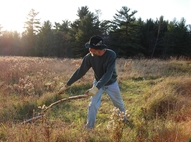|
In The Scythe Book, Tresamer talks about the tremendous diversity of plants that old-time pastures and hay fields used to have, and he also briefly mentions how farmers used to make special herbal hay with their scythes, for the health of their animals, and ultimately themselves. Here in this video below, a mountain farmer from Murau, Austria, explains the optimal stage at which to cut an herbal meadow, for the first cutting of hay, for maximum herbal strength and mineral content. She also talks about the healing properties of some of the herbs, and how much her cows enjoy and benefit from them. Modern fields have much less diversity, which is why she heads up high into the mountain to cut the old hayfields that mechanised farming hadn't adulterated. As for timing the first cut, conventional wisdom now is that the best time to mow for hay, is before the grass has started to head out, because it has the most protein at this stage. But from what I've read in old German scythe literature, the traditional time to mow the first cutting was "when the meadow is in bloom", as Maria Berger (Women's World Scythe Champion in 2000) is explaining in the video. Usually around St. John's Day, which is close to the summer solstice. Also happens to coincide with the longest day length of the year, for the quickest drying time of this massive volume of hay. To everything there is a season. "Auf steilen Berghängen sind die Wiesen nur händisch zu bearbeiten - dafür gibt´s dort viele Kräuter und Blumen. Die Bergbäurin Maria Berger aus Murau in Österreich weiss nicht nur, was sie am Sensenmähen so besonders mag, sondern auch, wann der beste Zeitpunkt für den ersten Schnitt ist. Nämlich dann, wenn die meisten Kräuter, Blumen und Gräser wachsen. Aus diesem Gras wird dann das Heu, das den Kühen besonders gut schmeckt." - zumursprung Translation: " Up on the steep alpine slopes, the meadows can only be harvested by hand - therefore a great natural diversity of medicinal wild herbs and flowers can still be found there. The mountain farmer Maria Berger of Murau, Austria, not only knows how to mow these meadows with a scythe, but also the best time of year to harvest. Namely when the most volume of herbs, flowers, and grasses are growing. The hay from this first cutting, tastes especially good to her cows." Here in the USA, another farmer has had the insight that mature grass may be better for cows than the young, high protein grass. Our own modern-day folk hero, Joel Salatin, writes in an article for Acres USA called Tall Grass Mob Stocking , "Prepare to be shocked. Most of us controlled grazing aficionados have been grazing when the forage is too short!" He goes on to say that the more mature grass has more carbohydrates, which is good for ruminant digestion. I've asked local organic dairy people about this, and they point out that Salatin raises beef cows. For maximum milk production, they say you need the younger grass for more protein. (I don't have cows, so I can't say, but could there be a difference between maximum milk production, vs. optimum milk quality? Much of our modern food system is based on maximum volume for cheapest selling price, rather than optimum nutritional quality for our health.) Salatin also mentions the nutritional benefits of a diverse pasture with herbs growing in it. "Salad Bar Beef", he calls it. Things to ponder for the upcoming haying season.
0 Comments
Your comment will be posted after it is approved.
Leave a Reply. |
Botan AndersonArchives
March 2023
Categories
All
|

 RSS Feed
RSS Feed